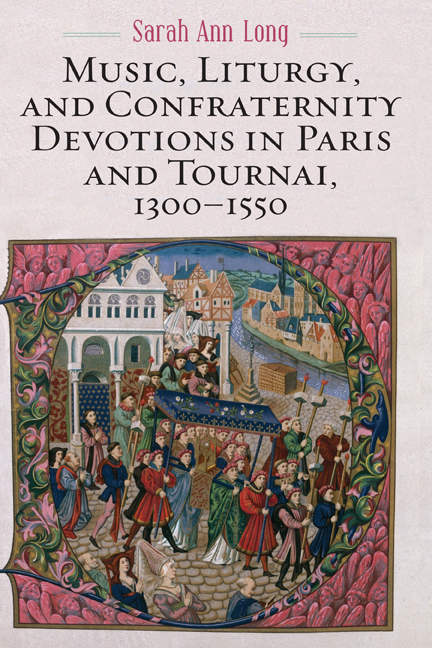Book contents
- Frontmatter
- Dedication
- Contents
- List of Illustrations
- Acknowledgments
- List of Abbreviations
- Editorial Procedures for Foreign Languages and Music Examples
- Note on Online Material
- Introduction
- 1 Confraternities and Popular Devotions to St. Barbara in Tournai
- 2 Relic Translation and Healing in Liturgies for St. Catherine and St. Nicholas in Paris
- 3 Historical Narratives and the Importance of Place in Masses for St. Sebastian
- 4 Compositional Practice, Networks, and the Dissemination of the Mass Ordinary in Confraternity Sources
- 5 The Role of the Parisian Book Production Community in the Perpetuation of Popular Devotions
- Conclusion
- Appendix 1 Sources
- Appendix 2 Inventories of Sources from Tournai
- Appendix 3 Scribal Hands and Gatherings in the Tournai Notary Confraternity Manuscripts
- Notes
- Bibliography
- Index of Chant and Polyphonic Compositions
- Index of Early Printed Liturgical Books
- Index of Manuscripts
- General Index
4 - Compositional Practice, Networks, and the Dissemination of the Mass Ordinary in Confraternity Sources
Published online by Cambridge University Press: 23 June 2021
- Frontmatter
- Dedication
- Contents
- List of Illustrations
- Acknowledgments
- List of Abbreviations
- Editorial Procedures for Foreign Languages and Music Examples
- Note on Online Material
- Introduction
- 1 Confraternities and Popular Devotions to St. Barbara in Tournai
- 2 Relic Translation and Healing in Liturgies for St. Catherine and St. Nicholas in Paris
- 3 Historical Narratives and the Importance of Place in Masses for St. Sebastian
- 4 Compositional Practice, Networks, and the Dissemination of the Mass Ordinary in Confraternity Sources
- 5 The Role of the Parisian Book Production Community in the Perpetuation of Popular Devotions
- Conclusion
- Appendix 1 Sources
- Appendix 2 Inventories of Sources from Tournai
- Appendix 3 Scribal Hands and Gatherings in the Tournai Notary Confraternity Manuscripts
- Notes
- Bibliography
- Index of Chant and Polyphonic Compositions
- Index of Early Printed Liturgical Books
- Index of Manuscripts
- General Index
Summary
Holy, Holy, Holy, Lord God of Sabaoth, you who were present on Mount Thabor and shone more brightly than the sun, Heaven and earth are full of your glory, Because on that day you mercifully appeared to your disciples, whom you have nourished. Hosanna in the highest. Blessed is he that comes in the name of the Lord to redeem the sins of the world, to whom we pray in supplication. Hosanna in the highest.
The opening of the text above is easily recognizable as that of the Sanctus, which is sung year-round as part of the Mass ordinary. The added words in italics are a trope text that was included with the chant in B-Tc A 58, a manuscript used by the Confraternity of the Transfiguration in Tournai. This troped Sanctus is known as the Sanctus “Vineux;” it alludes to the metamorphosis of Christ, commonly known as his Transfiguration, on Mount Thabor before the disciples Peter, James, and John. Although the Transfiguration was long celebrated as a feast in the Eastern Church, it only became offi-cially recognized in the Western Church in 1457 (celebrated on August 6). It was not a common theme in popular devotions among the laity before the early decades of the fifteenth century but was celebrated in clerical circles like the Confraternity of the Transfiguration before 1457. This organization consisted exclusively of priests and chaplains who held benefices at the Tournai cathedral.
The Sanctus “Vineux” is a good example of a work appearing in a number of sources that could illustrate personal connections between confraternities, ecclesiastical communities, and composers. The original melody is written in cantus fractus and also appears as the tenor of two polyphonic settings—one by Guillaume Du Fay and one by his presumed teacher, Richard de Locqueville—in the manuscript I-Bc Q 15. In this source, the word “Vineux” appears after an inscription just before the polyphonic setting by Locqueville: “Sanctus vineux secundum Locqueville.” It is also indicated with the name “Vineux” in several manuscripts where it appears in cantus fractus, implying that “Vineux” applies specifically to the monophonic tenor.
- Type
- Chapter
- Information
- Publisher: Boydell & BrewerPrint publication year: 2021



